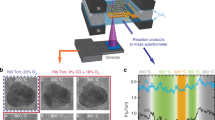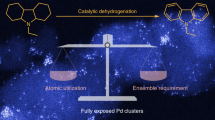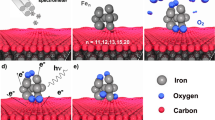Abstract
Finely dispersed nanometre-scale gold particles are known to catalyse several oxidation reactions in aerobic, ambient conditions. The catalytic activity has been explained by various complementary mechanisms, including support effects, particle-size-dependent metal–insulator transition, charging effects, frontier orbital interactions and geometric fluxionality. We show, by considering a series of robust and structurally well-characterized ligand-protected gold clusters with diameters between 1.2 and 2.4 nm, that electronic quantum size effects, particularly the magnitude of the so-called HOMO–LUMO energy gap, has a decisive role in binding oxygen to the nano-catalyst in an activated form. This can lead to the oxidation reaction 2CO + O2 → 2CO2 with low activation barriers. Binding of dioxygen is significant only for the smallest particles with a metal core diameter clearly below 2 nm. Our results suggest a potentially viable route to practical applications using ligand-protected gold clusters for green chemistry.
This is a preview of subscription content, access via your institution
Access options
Subscribe to this journal
Receive 12 print issues and online access
$259.00 per year
only $21.58 per issue
Buy this article
- Purchase on Springer Link
- Instant access to full article PDF
Prices may be subject to local taxes which are calculated during checkout





Similar content being viewed by others
References
Hutchings, G. J. & Joffe, R. A novel process for the co-synthesis of vinyl-chloride monomer and sodium-carbonate using a gold catalyst. Appl. Catal. 20, 215–218 (1986).
Haruta, M., Kobayashi, T., Sano, H. & Yamada, N. Novel gold catalysts for the oxidation of carbon-monoxide at a temperature far below 0 °C. Chem. Lett. 2, 405–408 (1987).
Haruta, M. Size and support dependency in the catalysis by gold. Catal. Today 36, 153–166 (1997).
Bond, G. C. & Thompson, D. Catalysis by gold. Cat. Rev. Sci. Eng. 41, 319–388 (1999).
Valden, M., Lai, X. & Goodman, W. Onset of catalytic activity of gold clusters on titania with the appearance of nonmetallic properties. Science 281, 1647–1650 (1998).
Sanchez, A. et al. When gold is not noble: nanoscale gold catalysts. J. Phys. Chem. A 103, 9573–9578 (1999).
Häkkinen, H., Abbet, S., Sanchez, A., Heiz, U. & Landman, U. Structural, electronic and impurity-doping effects in nanoscale chemistry: supported gold nanoclusters. Angew. Chem. Int. Ed. 42, 1297–1300 (2003).
Yoon, B. et al. Charging effects on bonding and catalyzed oxidation of CO on Au8 clusters on MgO. Science 307, 403–407 (2005).
Hughes, M. D. et al. Tunable gold catalysts for selective hydrocarbon oxidation under mild conditions. Nature 437, 1132–1135 (2005).
Turner, M. et al. Selective oxidation with dioxygen by gold nanoparticle catalysts derived from 55-atom clusters. Nature 454, 981–983 (2008).
Herzing, A. A., Kiely, C. J., Carley, A. F., Landon, P. & Hutchings, G. J. Identification of active gold nanoclusters on iron oxide supports for CO oxidation. Science 321, 1331–1335 (2008).
Ishida, T. & Haruta, M. Gold catalysts: towards sustainable chemistry. Angew. Chem. Int. Ed. 46, 7154–7156 (2008).
Meyer, R., Lemire, C., Shaikhutdinov, S. & Freund, H.-J. Surface chemistry of gold catalysis. Gold Bull. 37, 72–124 (2004).
Lopez, N. et al. On the origin of the catalytic activity of gold nanoparticles for low-temperature CO oxidation. J. Catal. 223, 232–235 (2004).
Kacprzak, K. A., Akola, J. & Häkkinen, H. First-principles simulations of hydrogen peroxide formation catalyzed by small neutral gold clusters. Phys. Chem. Chem. Phys. 11, 6359–6364 (2009).
de Heer, W. A. The physics of simple metal clusters: experimental aspects and simple concepts. Rev. Mod. Phys. 65, 611–676 (1993).
Taylor, K. J., Pettiette-Hall, C. L., Cheshnovsky, O. & Smalley, R. E. Ultraviolet photoelectron-spectra of coinage metal-clusters. J. Chem. Phys. 96, 3319–3329 (1992).
Häkkinen, H. Atomic and electronic structure of gold clusters: understanding flakes, cages and superatoms from simple concepts. Chem. Soc. Rev. 37, 1847–1859 (2008).
Lin, X. et al. Quantum well states in two-dimensional gold clusters on MgO thin films. Phys. Rev. Lett. 102, 206801 (2009).
Jadzinsky, P. D., Calero, G., Ackerson, C. J., Bushnell, D. A. & Kornberg, R. D. Structure of a thiol monolayer-protected gold nanoparticle at 1.1 Å resolution. Science 318, 430–433 (2007).
Walter, M. et al. A unified view of ligand-protected gold clusters as superatom complexes. Proc. Natl Acad. Sci. USA 105, 9157–9162 (2008).
Akola, J., Walter, M., Whetten, R. L., Häkkinen, H. & Grönbeck, H. On the structure of thiolate-protected Au25 . J. Am. Chem. Soc. 130, 3756–3757 (2008).
Heaven, M. W., Dass, A. White, P. S., Holt, K. M. & Murray, R. W. Crystal structure of the gold nanoparticle [N(C8H17)(4)][Au-25(SCH2CH2Ph)(18)]. J. Am. Chem. Soc. 130, 3754–3755 (2008).
Zhu, M., Aikens, C. M., Hollander, F. J., Schatz, G. C. & Jin, R. Correlating the crystal structure of a thiol-protected Au-25 cluster and optical properties. J. Am. Chem. Soc. 130, 5883–5885 (2008).
Lopez-Acevedo, O., Akola, J., Whetten, R. L., Grönbeck, H. & Häkkinen, H. Structure and bonding in the ubiquitous icosahedral metallic gold cluster Au144(SR)60 . J. Phys. Chem. C 113, 5035–5038 (2009).
Teo, B. K., Shi, X. B. & Zhang, H. Pure gold cluster of 1-9-9-1-9-9-1 layered structure—a novel 39-metal-atom cluster [(PH3P)14Au39Cl6]Cl2 with an interstitial gold atom in a hexagonal antiprismatic cage. J. Am. Chem. Soc. 114, 2743–2745 (1992).
Häkkinen, H., Walter, M. & Grönbeck, H. Divide and protect: capping gold nanoclusters with molecular gold-thiolate rings. J. Phys. Chem. B 110, 9927–9931 (2006).
Hammer, B. & Norskov, J. Why gold is the noblest of all the metals. Nature 376, 238–240 (1995).
Häkkinen, H. & Landman, U. Gas-phase catalytic oxidation of CO by Au−2 . J. Am. Chem. Soc. 123, 9704–9705 (2001).
Socaciu, L. D. et al. Catalytic CO oxidation by free Au−2: experiment and theory. J. Am. Chem. Soc. 125, 10437–10445 (2003).
Abbet, S., Heiz, U., Häkkinen, H. & Landman, U. CO oxidation on a single Pd atom supported on magnesia. Phys. Rev. Lett. 86, 5950–5953 (2001).
Leuchtner, R. E., Harms, A. C. & Castleman, A. W. Jr. Thermal metal cluster anion reactions: behaviour of aluminum clusters with oxygen. J. Chem. Phys. 91, 2753–2754 (1989).
Khanna, S. N. & Jena, P. Assembling crystals from clusters. Phys. Rev. Lett. 69, 1664–1667 (1992).
Castleman, A. W. Jr. & Khanna, S. N. Clusters, superatoms and building blocks of new materials. J. Phys. Chem. C 113, 2664–2675 (2009).
Brust, M., Walker, M., Bethell, D., Schiffrin, D. J. & Whyman, R. Synthesis of thiol-derivatized gold nanoparticles in a 2-phase liquid–liquid system. Chem. Commun. 801–802 (1994).
Zheng, N. & Stucky, G. D. A general synthetic strategy for oxide-supported metal nanoparticle catalysts. J. Am. Chem. Soc. 128, 14278–14280 (2006).
Liu, Y., Tsunoyama, H., Akita, T. & Tsukuda, T. Efficient and selective epoxidation of styrene with TBHP catalyzed by Au25 clusters on hydroxyapatite. Chem. Commun. 46, 550–552 (2010).
Tsunoyama, H., Ichikuni, N., Sakurai, H. & Tsukuda, T. Effect of electronic structures of Au clusters stabilized by poly(N-vinyl-2-pyrrolidone) on aerobic oxidation catalysis. J. Am. Chem. Soc. 131, 7086–7093 (2009).
Mortensen, J. J., Hansen, L. B. & Jacobsen, K. W. Real-space grid implementation of the projector augmented wave method. Phys. Rev. B 71, 035109 (2005).
Blöchl, P. E. Projector augmented-wave method. Phys. Rev. B 50, 17953–17979 (1994).
Perdew, J. P., Burke, K. & Ernzerhoft, M. Generalized gradient approximation made simple. Phys. Rev. Lett. 77, 3865–3868 (1996).
Tao, J., Perdew, J. P., Staroverov, V. N. & Scuseria, G. E. Climbing the density functional ladder: nonempirical meta-generalized gradient approximation designed for molecules and solids. Phys. Rev. Lett. 91, 146401 (2003).
Jonsson, H., Mills, G. & Jacobsen, K. W. Classical and Quantum Dynamics in Condensed Phase Systems (eds Berne, B. J., Cicotti, G. & Coker, D. F.) (World Scientific, 1998).
Henkelman, G., Uberuaga B. P. & Jonsson, H. A climbing-image nudged elastic band method for finding saddle points and minimum energy paths. J. Chem. Phys. 113, 9901–9904 (2000).
Bader, R. W. F. Atoms in Molecules: A Quantum Theory (Oxford Univ. Press, 1990).
CPMD V3.13 Copyright IBM Corp 1990-2008, Copyright MPI für Festkörperforschung Stuttgart 1997–2001 (http://www.cpmd.org).
Troullier, N. & Martins, J. L. Efficient pseudopotentials for plane-wave calculations. Phys. Rev. B 43, 1993–2006 (1991).
Car, R. & Parrinello, M. Unified approach for molecular-dynamics and density-functional-theory. Phys. Rev. Lett. 55, 2471–2474 (1985).
Acknowledgements
The authors thank H. Grönbeck for fruitful discussions. This research was supported by the Academy of Finland. Computer resources were provided by the CSC—Finnish IT Center for Science in Espoo.
Author information
Authors and Affiliations
Contributions
H.H. planned the research and wrote the manuscript draft. O.L.-A., K.K. and J.A. performed calculations and analysed the results. All authors contributed to editing the manuscript.
Corresponding author
Ethics declarations
Competing interests
The authors declare no competing financial interests.
Supplementary information
Supplementary information
Supplementary information (PDF 1653 kb)
Rights and permissions
About this article
Cite this article
Lopez-Acevedo, O., Kacprzak, K., Akola, J. et al. Quantum size effects in ambient CO oxidation catalysed by ligand-protected gold clusters. Nature Chem 2, 329–334 (2010). https://doi.org/10.1038/nchem.589
Received:
Accepted:
Published:
Issue Date:
DOI: https://doi.org/10.1038/nchem.589
This article is cited by
-
Supercrystal engineering of atomically precise gold nanoparticles promoted by surface dynamics
Nature Chemistry (2023)
-
Understanding ligand-protected noble metal nanoclusters at work
Nature Reviews Materials (2023)
-
Analysis of the Reduction of 4-Nitrophenol Catalyzed by Para-Mercaptobenzoic Acid Capped Magic Number Gold Clusters
Catalysis Letters (2022)
-
Triazine COF-supported single-atom catalyst (Pd1/trzn-COF) for CO oxidation
Science China Materials (2021)
-
Electrochemical Measurement of Bismuth Clusters in Dendrimer Through Transformation from Atomicity Controlled Complexes
Journal of Inorganic and Organometallic Polymers and Materials (2020)



